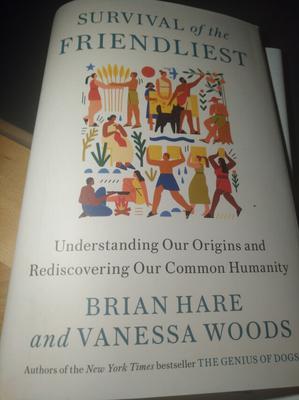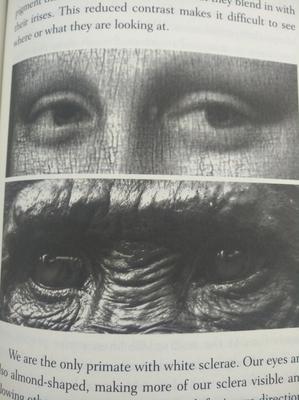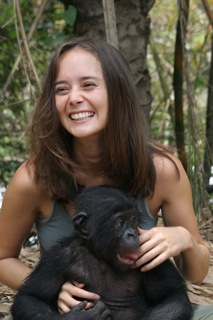Books - Read and Enjoyed
The Survival of the Friendliest
Understanding Our Origins and Rediscovering Our Common Humanity
Random House, New York, 2020
by Brain Hare and Vanessa Woods

The authors present the self-domestication hypothesis as supposedly the central evolutionary event that took place 70-80 thousand years ago and transformed homo sapiens from just another homo to a world conquering species. Domestication is the process when tolerance of humans is selected for by evolutionary pressure. It is commonly accepted that for instance dogs have evolved over many generations from their wolf ancestors by this process. Those individuals that tolerated humans better, that were friendlier towards humans, stayed consistently closer to human communities, benefited from the left-overs of human hunting and farming activities and therefore mated more often than not with other individuals close to a human group. Over many generations this process developed a species that eventually lived together with human bands and became part of their communities.
This process has also created all other domesticated animals like pigs, cows, goats, sheep, etc. Curiously it comes together with a number of other, seemingly non related traits like loss of pigments, curly tails, floppy ears, smaller brains, and the ability for longer breeding seasons. The process can be thought to generalize to other species, not only humans, and it can also work with the same species as target, which is then called self-domestication. Bonobos may have domesticated themselves. They are very similar to chimpanzees with the main difference that they act much more tolerant towards all other bonobos. While chimpanzees regularly are aggressive against each other and routinely kill other chimpanzees who are not from their own band, bonobos have never been observed to kill other bonobos, neither in the wild nor in a Zoo. The book explains how reduced aggressiveness may have become an evolutionary advantage which over time increased and then led to consistently friendly inter-species relations.
The self-domestication hypothesis contends that a similar process brought about a highly significant change of behavior to homo sapiens about 70-80 thousand years ago. While before that time homo sapiens was fairly similar to other members of the homo family such as the Neandertals, Homo erectus, or homo floresiensis, fairly unremarkable and fairly unsuccessful, after this change it quickly spread to all corners of the planet and drove extinct not only all other hominin species but dozens of other large vertebrates either by competition or by over-hunting. Fascinatingly, because domestication goes together with change of traits in the body and bone structure, as mentioned above, it can be traced in the archaeological record. And that record seems to give support to this hypothesis.

Self-domestication has increased the tolerance towards other humans outside the narrow group or family. Early humans and probably most other hominins lived in bands of a up to a few dozen members where everybody intimately knew every other individual by sight, smell and touch. Members of other bands were not tolerated and if possible killed or driven away. But self-domestication led to an increased tolerance towards outsiders, that facilitated communication and collaboration. This ability to collaborate with strangers proved to be extremely powerful because it facilitated long distance trade routes and complex, differentiated societies that consisted of hundreds or thousands of members, living over large areas. Hence, humans could cooperate with strangers even though they may not have met each other.
The change that was brought about by self-domestication concerns the criteria by which a friend is recognized. In other hominin groups and in today’s groups of chimpanzees and apes the criteria are touch and smell and having lived with one another over an extended period. It relies upon intimate knowledge of each other and being close to each other over long periods of time. This limits the number of individuals that can belong to one group and it makes it difficult that a stranger becomes accepted as a friend. And when a stranger from another group becomes a friend, he or she cannot continue to be part of the other group anymore. But with self-domestication the criteria for friendship became more flexible, almost arbitrary and much easier to pass. It could be a specific color of the hair, a particular type of weapon, a specific symbol worn around the neck, or a dialect of the language. It could be different for different groups and it could depend on whatever was best suited for a particular purpose such as to be distinguishable from another group, to make trade networks work, or to conduct a big hunt. This increased flexibility in forming groups of friends unleashed the enormous potential of nearly unlimited cooperation. Indeed, today there are societies with over a billion members that consider themselves connected, and it is quite conceivable that this number may one day become as large as ten billion.


Self-domestication proved exceedingly successful in cooperation, building culture and technology, but it did not go all the way as in bonobos. While bonobos treat all strangers as potential friends, humans do not. They have maintained the notion of friend-group and enemy-group. Although the increase of flexibility in selecting the distinguishing criteria allowed to expand the friend-group to the size of millions and even billions, it did not eliminate the ability to identify enemy-groups. In fact, this ability seems not to have weakened and is probably as strong as it is in chimpanzees. The book elaborates this aspect quite extensively and describes some of the mechanisms at work. It makes a deliberate attempt to link our distance evolutionary past with the politics of the day.
The book is easy to read and self-domestication is certainly a highly interesting hypothesis. Sometimes I wished some more details were given and arguments were more carefully developed. For instance I found the claim that “self-control” depends directly on the brain size not at all compelling. At least the arguments for this connection were not elaborated. Also, I would have loved to learn, how well this hypothesis is accepted in the scientific community and which alternative hypotheses are entertained.
These rather minor limitations notwithstanding I enjoyed reading the book because it illuminates one fascinating aspect of the evolution of our species.
(AJ September 2020)
